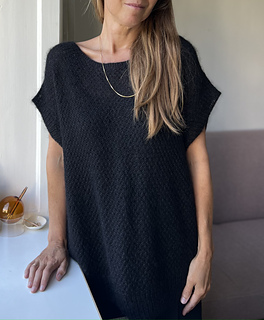patterns >  RefinedKnitwear and 1 more...
RefinedKnitwear and 1 more...
> Fungus Slipover









Fungus Slipover
Description
The Fungus Slipover is a feminine oversized drop-shoulder slipover knitted in a neat double-height moss stitch pattern. It is knitted from the top down, beginning with the ribbed neckline. Increases are made on either side of three shoulder stitches on each side of the yoke. The yoke is first knitted back and forth with short rows to shape the neckline, and then it is knitted in the round until the slipover reaches the desired width, at which point the shoulder increases stop. The front and back pieces are then knitted separately back and forth until the armhole reaches the correct depth. From here, the work is joined, and it is knitted in the round. Stitches are picked up along the armhole to knit the armhole edges.
Sizes
2XS (XS) S (M) L (XL) 2XL (3XL) 4XL
Finished Measurements
Bust circumference: approx. 109 (113) 118 (127) 131 (135) 144 (149) 153 cm.
Body length measured center back (CB): approx. 57-61 (59-63) 60-64 (62-66) 64-68 (66-70) 68-72 (69-73) 70-74 cm.
The slipover is designed with 15-30 cm of positive ease, but if you prefer a tighter or looser fit, you can size up or down. The model in the picture has a bust measurement of 84 cm and is wearing size XS with about 29 cm of positive ease. The recommendation is to aim for a wide ease in the smaller sizes and a narrower ease in the larger sizes.
When deciding to go with a length of 20-24 cm after joining the body of the slipover, a version with 24 cm was chosen for the version shown here.
Materials
100 (100) 100 (150) 150 (150) 150 (200) 200 g of Trio 1 from Isager Yarn (350 m/50 g) or 150 (150) 150 (200) 200 (250) 250 (300) 300 g of Isager Tweed from Isager Yarn (200 m/50 g) or 150 (150) 150 (150) 200 (200) 250 (300) 300 g Alpaca 2 from Isager Yarn 250 g/50 g or 150 (150) 150 (200) 200 (250) 250 (300) 300 g of No Waste Wool from Knitting for Olive (225 m/50 g) or 150 (150) 150 (150) 200 (200) 250 (300) 300 g of Pure Silk or Merino from Knitting for Olive (250 m/50 g) held together with 100 (100) 100 (100) 100 (125) 125 (150) 150 g of Soft Silk Mohair from Knitting for Olive (225 m/25 g) or similar silk mohair quality, such as Silk Mohair from Isager Yarn (212 m/25 g) or Önling No. 10 from Önling (210 m/25 g).
The slipover can also be knitted up in 2 strands of Silk Mohair, then you must double the amount of Silk Mohair mentioned here.
The slipover in the picture is knitted with one strand of Trio 1 in the color Ink and one strand of Silk Mohair in the color 30. Both qualities from Isager Yarn. This combination gives an airy expression to the moss stitch pattern.
In addition to the yarn, you will need 5 stitch markers, 2 of which should be able to open like safety pins.
Recommended Needles
The slipover is knitted in double-height moss stitch pattern both back and forth and in the round on a 4 mm circular needle (80 cm) with one strand of Trio 1 held together with one strand of Silk Mohair.
It is recommended to have 2 circular needles of 4 mm so that stitches that need to rest can sit on one circular needle while you knit with the other, but you can also use a cord or stitch holder instead.
The ribbing on the neckline is knitted on a 3 mm circular needle (80 cm). The ribbing on the armholes, and at the body edge are knitted on a 3.5 mm circular needle (80 cm).
I recommend the Magic Loop method for knitting the upper part of the yoke and the armhole edges. If you do not use the Magic Loop method, you will also need a 4 mm circular needle (40 cm), a 3.5 mm circular needle (40 cm), and a 3 mm circular needle (40 cm).
Gauge
18 sts x 26 rows = 10 x 10 cm on 4 mm needles back and forth and in the round in double-height moss stitch.
10592 projects
stashed
8533 times
18497 projects
stashed
8255 times
3708 projects
stashed
2640 times
15983 projects
stashed
6374 times
9527 projects
stashed
6016 times
12321 projects
stashed
7567 times
20273 projects
stashed
8999 times
2675 projects
stashed
1572 times
31309 projects
stashed
15144 times
154 projects
stashed
142 times
- First published: September 2024
- Page created: September 7, 2024
- Last updated: October 9, 2024 …
- visits in the last 24 hours
- visitors right now




